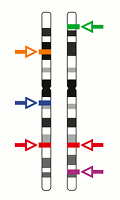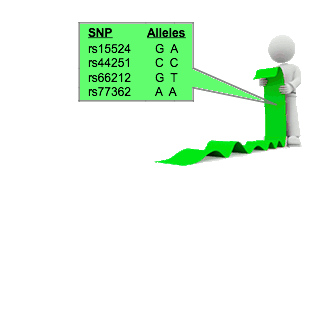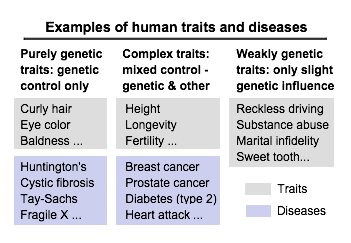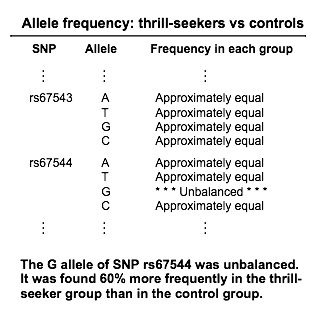Genomics
Education
Initiative

SNPsAndChips.com
What's a SNP, what's a chip,
As described in the previous section, DNA chips make it easy to obtain a report that lists a person's alleles at up to one million SNPs.
(Remember: SNPs are chromosomal addresses that can have different alleles. Everyone has two copies of each.)
Anyone may obtain a SNP report from one of several on-line genome scanning companies. One simply sends in a sample of saliva or a cheek swab (together with a fee). A week or two later, the company sends back the report.
(Point to the image to show the complete figure.)
If we collect data from a group of people, we rapidly build up a very large database: one million SNPs per person. Such a database is a rich source of information about humans in general, and about the individuals in the group.
The field of genomics is the science of "mining" databases like this. Genome specialists study SNP data intensively, looking for patterns that correlate with human characteristics.


The range of human traits that have been studied is very broad. Genome specialists have looked for SNPs that are associated with:
- simple physical traits such as curly hair or attached earlobes
- complex social behaviors like reckless driving or marital infidelity
- medically relevant properties such as risk of breast cancer, prostate cancer, or diabetes
(Point to the image to show the complete figure.)
Some of these traits are purely genetic, but most are not. Take longevity, for example. Genetic background (i.e. the SNPs inherited from parents) is a key factor. But other things (diet, lifestyle, accidents, etc.) also affect longevity. Genomics cannot predict an individual's life span, but it can identify those more likely than average to live long.
Likewise for complex diseases. Genomics cannot predict who will or will not get sick, but it can reveal important relative risks.


To illustrate, consider a hypothetical example. Suppose we wish to find a SNP associated with excessive love of (addiction to) roller coasters. That is, we wish to find a "thrill-seeker" SNP.
If we find such a SNP, it will be marker for the thrill-seeker trait. Anyone who has that marker in their DNA will be more likely than average to be addicted to roller coasters, and we will be able to calculate the degree of this likelihood.
(Point to the image to show the complete figure.)
To look for our marker, we build two databases of SNP alleles: one from people who ride roller coasters excessively often, and one from people chosen at random from the general public.
Then we compare the two. At most SNPs there will be no difference between the two groups. However, if a SNP is genetically linked to our trait, it will show up as an imbalance in our data. At that SNP, one allele will occur more frequently in one group than in the other.
(Point to the image to show the complete figure.)
In this hypothetical example we find that SNP rs67544 is genetically linked to our trait. That is, one allele (G) is present 60% more often in "thrill seekers" than in the general population.
Thus, SNP rs67544 is a marker for the "thrill seeker" trait. People with this marker have a 60% higher risk of "addiction to roller coasters" than "average people". Having the G allele here does not guarantee the addiction, but it does indicate an above average relative risk.
(Point to the image to show the complete figure.)
This fictitious example raises several questions:
- Are the conclusions we reached valid?
- Can they be extended beyond our study groups to the population as a whole?
- Can the same method be used to find SNPs linked to other, more important properties, like risk of diabetes, cancer, or heart disease?
- Are there benefits to genetic tests that can measure a person's disease risk relative to the population, but cannot say for sure whether that individual person will get sick?



